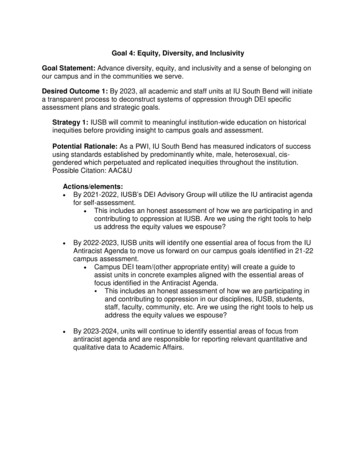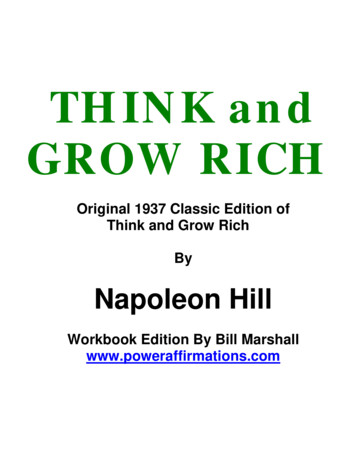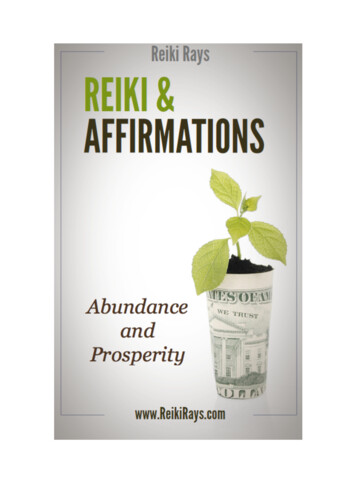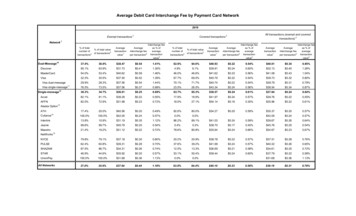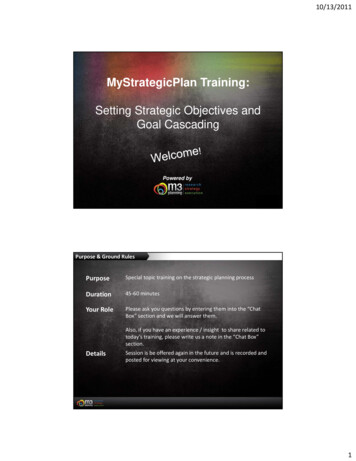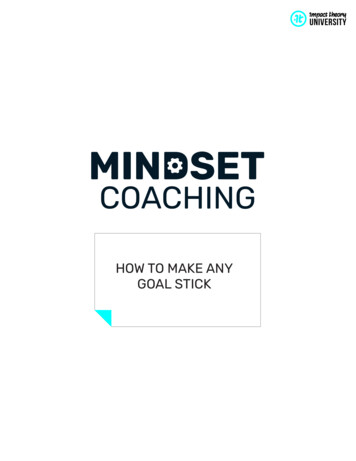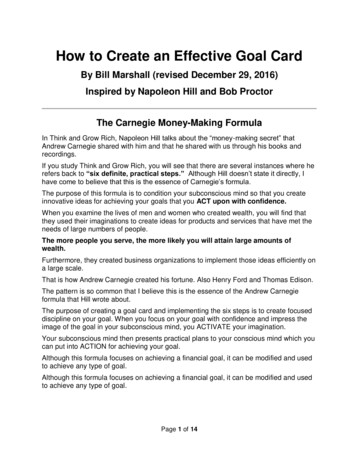
Transcription
How to Create an Effective Goal CardBy Bill Marshall (revised December 29, 2016)Inspired by Napoleon Hill and Bob ProctorThe Carnegie Money-Making FormulaIn Think and Grow Rich, Napoleon Hill talks about the “money-making secret” thatAndrew Carnegie shared with him and that he shared with us through his books andrecordings.If you study Think and Grow Rich, you will see that there are several instances where herefers back to “six definite, practical steps.” Although Hill doesn’t state it directly, Ihave come to believe that this is the essence of Carnegie’s formula.The purpose of this formula is to condition your subconscious mind so that you createinnovative ideas for achieving your goals that you ACT upon with confidence.When you examine the lives of men and women who created wealth, you will find thatthey used their imaginations to create ideas for products and services that have met theneeds of large numbers of people.The more people you serve, the more likely you will attain large amounts ofwealth.Furthermore, they created business organizations to implement those ideas efficiently ona large scale.That is how Andrew Carnegie created his fortune. Also Henry Ford and Thomas Edison.The pattern is so common that I believe this is the essence of the Andrew Carnegieformula that Hill wrote about.The purpose of creating a goal card and implementing the six steps is to create focuseddiscipline on your goal. When you focus on your goal with confidence and impress theimage of the goal in your subconscious mind, you ACTIVATE your imagination.Your subconscious mind then presents practical plans to your conscious mind which youcan put into ACTION for achieving your goal.Although this formula focuses on achieving a financial goal, it can be modified and usedto achieve any type of goal.Although this formula focuses on achieving a financial goal, it can be modified and usedto achieve any type of goal.Page 1 of 14
The Six StepsThe method by which DESIRE for riches can be transformed into its financial equivalent,consists of six definite, practical steps:First. Fix in your mind the exact amount of money you desire. It is not sufficientmerely to say “I want plenty of money.” Be definite as to the amount. (There is apsychological reason for definiteness which will be described in a subsequentchapter).Second.Determine exactly what you intend to give in return for the moneyyou desire. (There is no such reality as “something for nothing.)Third.desire.Establish a definite date when you intend to possess the money youFourth.Create a definite plan for carrying out your desire, and begin atonce, whether you are ready or not, to put this plan into action.Fifth. Write out a clear, concise statement of the amount of money you intend toacquire, name the time limit for its acquisition, state what you intend to give inreturn for the money, and describe clearly the plan through which you intend toaccumulate it.Sixth.Read your written statement aloud, twice daily, once just beforeretiring at night, and once after arising in the morning. AS YOU READ—SEEAND FEEL AND BELIEVE YOURSELF ALREADY IN POSSESSION OF THEMONEY.It is important that you follow the instructions described in these six steps. It isespecially important that you observe, and follow the instructions in the sixthparagraph. You may complain that it is impossible for you to “see yourself inpossession of money” before you actually have it.Here is where a BURNING DESIRE will come to your aid. If you truly DESIRE money sokeenly that your desire is an obsession, you will have no difficulty in convincing yourselfthat you will acquire it. The object is to want money, and to become so determined tohave it that you CONVINCE yourself you will have it.Only those who become “money conscious” ever accumulate great riches. “Moneyconsciousness” means that the mind has become so thoroughly saturated with theDESIRE for money, that one can see one’s self already in possession of it.The steps call for no “hard labor.” They call for no sacrifice. They do not require one tobecome ridiculous, or credulous. To apply them calls for no great amount of education.But the successful application of these six steps does call for sufficient imagination toenable one to see, and to understand, that accumulation of money cannot be left tochance, good fortune, and luck. One must realize that all who have accumulated greatfortunes, first did a certain amount of dreaming, hoping, wishing, DESIRING, andPLANNING before they acquired money.Page 2 of 14
You may as well know, right here, that you can never have riches in great quantities,UNLESS you can work yourself into a white heat of DESIRE for money, and actuallyBELIEVE you will possess it.Making Hill’s Formula More Practical Using a Goal CardOne of the tricks to making Hill’s formula practical is to adapt his words to your situationand write them on a simple 3 x 5 goal card.Your goal card can become your gold card.While Napoleon Hill stressed the importance of writing out your goal statement, I don’tsee any place where he gave instructions for using a 3 x 5 card.While it may be self-evident to many people that writing the formula on a goal card is aneffective way to implement it, the idea never occurred to me until I started studying BobProctor’s material. Since I started using a goal card regularly, I have been moreconsistent in following the formula and have been achieving even better results thanbefore.The ideas that I’m outlining here are what really made Hill’s 6 steps practical for me.Some of the ideas I received from studying Napoleon Hill and Bob Proctor, and some Ideveloped on my own.Until I used a handwritten goal card (not paper, not a journal, not iPad, not computer,not iPhone, etc.) I did not consistently follow Napoleon’s 6 steps.It costs virtually nothing, is simple to use, and (most importantly) it is effective—whenyou know what to put on the card and how to use it correctly. That’s what this whitepaper is about.Why is a goal card effective?Because it makes it easy for you to stay focused on your goal using the principle ofspaced repetition. And when you stay focused on a goal for a sustained period of time,mixed with the belief that you will achieve it, the odds of achieving it increasedramatically.As Bob Proctor teaches, we think in pictures. A goal card helps you to create a clearmental image of what you want so that you properly impress that image into yoursubconscious mind.When you do that, ideas will pop into your head throughout your day for attaining thegoal. Your belief, self-confidence, and motivation will be at a level where you act onthose ideas. One of the lessons I learned from Bob is that impressing the image of yourgoal on your subconscious mind causes your body to move into action automatically.You will be compelled to take action.You have seen this happen with other people and you’ve seen this happen with yourself.They take the initiative to act. You don’t have to push a motivated person to take action,you just have to get out of their way. And when you take effective action, you will makeprogress to achieve your goals.Page 3 of 14
When YOU are highly motivated, YOU take the initiative to act.How To Create Your Goal CardTo follow Napoleon Hill’s formula, an effective goal card has more on the card than just astatement of the goal. In other words, if you want to attract or create a specific amount ofmoney or a material possession, your card needs to have more on it than just astatement of what you want. You need to also state what you intend to give in return forachieving your goal. Otherwise, you are not following Napoleon Hill’s formula.Here are my specific suggestions for creating your card:1. Use a blank, 3 x 5 card. The reason I use a 3 x 5 card is that it is large enoughto include all of the information I am about to suggest, but still small enough to fitin your pocket. I have found business card sizes to be too small and larger cardsizes to be too big. Also, because the 3 x 5 is a standard size, they are cheapand plentiful.2. When you write out your goal card, write it out by hand in blue ink. Don’tuse a computer and print it. Without getting too technical, writing out your goal byhand helps to build the new patterns in your brain you need to achieve your goal.Also, the vibrational energy of the color blue is a very creative energy. As youlook at your handwritten goal card in blue ink, it has a more creative effect thanusing a different color—like black. You may think this is odd, but put it to the testand see for yourself.3. How many goals should you put on your goal card? This is a question that Iam asked frequently. Put only one goal per goal card. The reason is simple:FOCUS. When you review your goal card, you should focus all of your thoughenergy and mental imagery on the attainment of that goal.4. How many goal cards should you create? This is another common question.My recommendation is one goal card at a time. I recommend that you chooseyour most important “umbrella goal.” An “umbrella goal” is a goal that makes it alot easier to achieve your other goals.In my personal experience, this is almost always my most important financial goal.Is that because money goals are more important than other goals? No!!!So why focus on money goals for my goals card? Because achieving a specificmonetary goal usually makes it easier for me to achieve my other goals.If you had 10 million dollars in the bank, how much easier would it be for you toachieve your other goals?What I do is this: I have a list of my most important goals by category. I reviewthat list and come up with an “umbrella goal” that will allow me to achieve most ofthese other goals more easily. I turn that “umbrella goal” into my goal card.Page 4 of 14
I review my list of goals multiple times per week. I review my goal card multipletimes per DAY.5. Choose your words carefully. Quite often people want to achieve a financialgoal. When I have a financial goal, I use the words adapted from “Think andGrow Rich” by Napoleon Hill. I am going to give you my version of these wordsafter these instructions.6. After you write your goal card, I suggest you laminate it. This single idea hasincreased my own effectiveness with goal cards by at least 10 times.While I state this as a suggestion, I personally treat it as a mandatory step. Youmay think this is too much trouble and the extra effort is unnecessary. Myquestion to you is “are you getting the results you want?” If not, you may want toconsider this. How important is it to you to achieve your goal?Initially, I didn’t use any protection for my card and it quickly wore out as I carriedit in my pocket. I found it became more of a nuisance than a help. It didn’t put mein the right frame of mind.Then I used a plastic sleeve. I got that idea from Bob Proctor. That was better,but it was difficult to find one that fit properly. And it too had a tendency to get outof shape after a few days.Then I decided to laminate the card. You can do this for just a few dollars a cardat places like FedEx Office. In my case, because I like the convenience oflaminating cards any time, I decided to purchase a laminator at Staples. I thinkthe price was about 50 plus about 10 for 25 3 x 5 pouches—they have aspecific pouch just for 3 x 5 cards.If for some reason, you don’t have any way to laminate your card, then use cleartape to protect it. Where there is a will, there is a way.7. Create several copies of your goal card so one is always within easy reach.Make it easy for you to review your goal card several times per day.For example, I have a goal card that I carry around with me in my pocket, one inthe bathroom, one in the car, and one by my bed. All four cards say the samething and all are laminated.Page 5 of 14
What to Say On Your Goal CardIn chapter 4 of Think and Grow Rich, (called Autosuggestion), Napoleon Hill revisited the6 steps I mentioned at the beginning of this white paper and provided a practical, writtenformula I have found to be very effective.While the formula was originally about money, you can easily adapt it to a wide variety ofdifferent goals. For example, a goal to get a certain car, a house, a job, etc. I’ve usedvariations of this formula for years.Here is the wording based on the material from “Think and Grow Rich” (with some minorchanges):“I am so happy and grateful that by (insert date), I will have in mypossession (insert amount), which will come to me in various amounts fromtime to time during the interim.“In return for this money I will give the most efficient service of which I amcapable, rendering the fullest possible quantity, and the best possiblequality of service in the capacity of (describe the service or merchandiseyou intend to offer in exchange for the money).“I believe that I will have this money in my possession. My faith is so strongthat I can now see this money before my eyes. I can touch it with my hands.It is now awaiting transfer to me at the time, and in the proportion that Ideliver the service I intend to render in return for it. I am awaiting plans bywhich to accumulate this money, and I will immediately follow those plansas they are received.”Then, sign and date your card. Your signature reinforces your commitment to achieveyour goal. I like to use my full, legal name. A date allows you to keep track of yourstarting point.I have found Hill’s wording to be a perfect starting point for me when it comes tofinancial and material goals. I say starting point, because I find that I make minorrevisions to my statement as ideas pop into my head to use it. He only meant it to be anexample for us to start with.These points may help you understand the psychology behind the wording and why it isso effective:1. It sets a specific target in your mind. You want to state your goal in such a waythat it creates a clear mental image in your mind. Remember, we think inpictures. The date is definite and the goal is definite. Choosing a date for yourgoal is a bit of an art.On the one hand, you want to be aggressive so that you don’t short changeyourself.On the other hand, you don’t want to so aggressive that you don’t allow yourselfenough time to grow into the goal.Page 6 of 14
The best way I know of to come up with a date is to answer this question: howquickly will you be able to provide the level of service that entitles you to receivewhat you want?If you want the money faster, find a way to deliver your products and services tomore people faster.2. It outlines the service you intend to provide in exchange for achieving yourgoal. I don’t believe in “something for nothing” especially when it comes tomoney. This affirmation reminds you that you have to deliver both sufficientquantity and quality of service in order to achieve your goal.In my experience, this paragraph generates a number of useful ideas over aperiod of time. Usually what happens is that after using the affirmation for a fewdays, I start clarifying and expanding the products and services I intend to renderin exchange for the goal.I usually end up with ideas related to multiple-streams of income (MSI’s) ratherthan relying on only one.I received the idea for MSI’s from Bob Proctor. An MSI may be a job, a business,an investment, etc. If you study wealthy people, you will find that a job is one ofthe weakest sources of income because you are usually trading your time formoney.A business or investment is a better source because it can be a “passive” sourceof income. In other words, you are paid for the value you create regardless ofhow much or how little time it takes to create it.One of the best case scenarios is when you do the work once but get paid manytimes. For example, an author may write a book once, but get paid on it for years.Or an actor may be in a movie one time, but get paid for as long as that moviecontinues to generate revenues.3. Now comes a statement of belief. Notice the two statements “ I can now seethis money before my eyes. I can touch it with my hands.” This type ofmental imagery is critical to getting the idea of what you want firmly planted orimpressed into your subconscious mind. Everything you create in your life firststarts in your mind.4. Notice again the emphasis on exchanging service for what you want. Whatyou desire, in this case the amount of money you want, already exists. It isalready sitting around in various banks all around the world. And if it isn’t alreadyin the banks, they can create it in a millisecond. Remember: there was a time inhistory that money didn’t exist. Human kind created it to make it store serviceand facilitate transactions. If the human race created money, we can create moreas we need it.Your job is to create a proportional amount of value you want to exchange forthe money. Your job is to provide valuable and useful service to others. InPage 7 of 14
fact, the value of the service you provide should exceed what you are asking for.In my mind, I usually assume the value of the service I intend to render is at least10 times the amount I’m looking for. The amount depends on your net profit perunit of service or product sold.So for example, if you want to earn 100,000, you should expect to provide amillion dollars or more worth of service. You could provide a million dollars ofservice to one person (difficult) or you could provide 10 of service to 100,000people. That is actually a lot easier to do because you can reach a lot of peopleefficiently over the internet.I like to play around with the math in my head as it allows me to think of ways tobreak down my goal so that achieving it is more believable.5. This wording reminds me that I need a plan to achieve my goal. Also, itallows me to get started even before I have a specific plan. If you read “Think andGrow Rich” carefully, you will find that he states in many places that you have toset a definite goal and create definite plans for its attainment.But you don’t need to know the exact plan in order to get started. Notice Isaid get started. This idea was clarified for me by Bob. You don’t need to knowhow you are going to achieve your goal in the beginning. No one knew how theywere going to achieve their goal until they achieved it.You only need to create a clear mental image of what you want to start. And toget emotionally involved with that image. When you move forward in faith, youwill eventually get all of the plans and resources you need to attain your goal.You will eventually need to create effective plans for achieving your goals, butthese will only come AFTER you get started and NOT before. Don’t let anythingstop you from starting to move towards your goal immediately.Not starting one of the major reasons people don’t attain their goals. People talkthemselves right out of even trying for their goal through negative self-talk. Theyare so stuck on the “how” that they never get started. Forget how for now.First concentrate on creating a clear mental picture of what you want. Then goas far as you can see right now. You will learn how you are going to achieve yourgoal during the process of working toward it.Here is a very important point that I learned from Bob Proctor: setting a goal andachieving a goal are two different activities. Setting the goal is an intellectualactivity of deciding what you want and the service you intend to render in returnfor it.Achieving your goal is a lawful process. What I mean by that, is you use thelaws of the universe (e.g., law of attraction, law of vibration, law of gender, causeand effect, etc.) to achieve your goal.Page 8 of 14
Planting the image of your goal in your subconscious mind through repetition ispart of the achievement process.What to Say On Your Goal Card: Short FormHere is a very simple, one sentence version of a goal statement that comes from BobProctor’s material. Here it is:“I am so happy and grateful that by [insert date], I will [statement of goal].”For example, “I am so happy and grateful that by December 31, 2016, I will earn anannual salary of 100,000 as a business systems analyst.”Here’s an example of a non-financial goal:“I am so happy and grateful that by December 31, 2016 I will healthfully weigh myideal weight of 170.”Here are some advantages of this formula:1.2.3.4.You can easily fit on a business card.It is easy to memorize and repeat multiple times per day.It is easy to write out as a written affirmation.It captures most of the essential elements: a positive feeling, a date, and aspecific goal.I use both forms. I like the longer form for my primary financial goal. I find that the extrainformation helps me to better visualize the goal, reminds me of the importance ofservice, inspires strong confidence, and helps me create plans.Because I have memorized the long version of the affirmation and use it regularly, I findthat the short version goal card reminds me of the long version.How to Use Your Goal Card Effectively1. Read the card both silently and out loud several times a day. At the veryleast when you wake up and just before you go to sleep. I think more often ismandatory at the beginning. The more you read the card, the more often you willfocus your imagination on the mental image of your goal. I find that every time Ifocus my imagination on the mental image of my goal, it becomes clearer.But space it out during the day—constant, spaced repetition. Eventually, you willfind yourself thinking about your goal and your goal card continuously. And carryyour card in your pocket, pocketbook, or wallet. As I have learned from BobProctor, eventually the image of your goal will flash into your mind just fromPage 9 of 14
touching your card.This is how you build the obsessional desire that Napoleon Hill says is essential tosuccess.2. Memorize the words. Most people find this happens automatically after a fewdays. Even at that point, I still recommend that you hold and read the card.Touching your card and using your physical sight helps reinforce the image of thecard and your goal in your mind.3. Meditate on the words and visualize your objective. During the times that youread the card, really stop and think about what the words mean. Letters andwords are really symbols. You want to focus your attention on the meaningbehind the symbols. What are the internal sensations triggered by the words(images, sounds, feelings, smell, and tastes)? Pay special attention to yourfeelings. Your feeling is an indication of your vibration. Your vibration sets up theattraction.Use your imagination. Sharpen the image of what you want in your mind. Getmore definite about the service you intend to offer in exchange. Think about ideasof how you are going to attain the goal and write those ideas down as theycome to you. This is one of the most effective ways you will find for coming upwith your plan.4. Re-write your goal statement. Periodically, I like to re-write my statement tohelp me think through the words. Often I will come up with slight changes inwording that improves the statement. This is really important. Sometimesadding or changing even one or two words makes a big difference.If the change is significant, I usually create new, laminated goal cards.5. Get emotionally involved with the idea of your goal. I initially learned this fromNapoleon Hill, but Bob Proctor clarified this even more for me. Feelings, images,and emotions are the “language” of the subconscious mind. The emotion of faithwill allow you to create the belief that your goal is attainable. The emotion ofenthusiasm will spur you to action. The emotion of gratitude will keep yourattitude positive and attractive. The only way to impress the idea of what youwant on your subconscious mind is mixing it with emotion or feeling.The money you want to achieve is already in the hands of someone else. Youattract money by being more attractive to people. I’m not referring to physicalattractiveness (though it helps to make yourself as physically attractive aspossible). I am primarily referring to gratitude and other positive emotions.Those “vibrations” are very attractive to people. When you have a positive,grateful attitude, you will attract other people. And when you are attractive toother people, they will go out of their way to help you and will willingly purchaseyour products and services.Page 10 of 14
I hope that you have found this white paper to be helpful. There are other visualizationtools that are useful—vision boards, dream boards, dream books, mind movies, etc.They all have their place. But because of its portable convenience and compactness, Ibelieve that a simple, laminated goal card is much more effective than any of these.We live in an age when most of us are pressed for time. While these other methods areeffective, many people will not use them because they can take a lot of time to create.But an effective goal card can be created within minutes.I think it is more effective than only entering your goals into your computer and yourphone because it’s handwritten and always available (if you have followed myinstructions). There is nothing to turn on or find. Just pull it out and read it.My challenge to you: Follow the instructions in this white paper faithfully andconsistently for the next 30 days and watch what happens. 90 days is even better.You will be amazed at how your thinking improves and how much progress, youmake towards your goal.After you master this technique with one goal, then start doing it with other goals.What To Do When It Seems It “Isn’t Working”I learned this primarily from Bob Proctor’s material.I say “when it seems it isn’t working” because the process is always working. It’s basedon a law a natural as the law of gravity. Can you imagine the law of gravity not workingfor even a fraction of a second? That’s never going to happen. The laws of nature/theuniverse always work 100% of the time, no exceptions.If there is a problem, the reason lies with us, not with the law. It simply means we havenot yet reached the level of awareness necessary to achieve our goal.According to Bob Proctor, the real purpose for setting and achieving goals is NOT theobject of the goal itself. The big win is the person we become in the process ofreaching the goal. The real win is the new level of awareness that we attain.This was a new revelation to me. Prior to this explanation, my focus was on simplyattaining the goal.As Bob Proctor says, “If someone is only earning 50,000 a year, it isn’t because theywant to earn 50,000 per year. It’s because they haven’t reached the level of internalawareness that is required to achieve 200,000 a year. Or even 50,000 a month.”There are people who have turned their annual income into a monthly income. Whatothers have done, you can do also—if you do the inner work.Success is always an inside job. You will succeed from the inside out. It’s moreeffective, a lot more peaceful, and you will be happier in the end than in the beginning.People who focus on the external object of the goal rather than on the higher level ofawareness/consciousness get to the end and say “is that all there is?” They may haveachieved their goal, but at what price?Page 11 of 14
Why Being Positive is Difficult—At FirstConsistently thinking positive is difficult at first until it becomes a habit. The reason isbecause most of the people in the world are negative. We are surrounded with negativethinking. It’s in the media. It’s at our jobs. It’s in the people in our environment.And because every brain is both a broadcasting and receiving station, everyone of usare picking up vibrations of negative thoughts released by other people. Until you realizethis is happening, the odds are very high that you will be influenced by these negativethoughts.After you recognize this is happening, you can set up a system to defend yourselfagainst these thoughts.According to Bob Proctor, when we are born, we come into this world with a “cleanslate.” Our intellectual factors are undeveloped. We haven’t learned how to use ourconscious minds. And so, whatever is happening in our environment (positive ornegative) passes straight through to our subconscious mind and becomes fixed as ahabit.This is why we speak the languages we speak. That’s why you are able to read andunderstand these words. You weren’t born with this knowledge. This is why we eat thefoods we eat. We inherit the habits of our environment.After we reach the age of understanding where our conscious minds are developed, wehave the ability to consciously accept or reject any thought. But so much of our thinkingis so habitual by that point, most people don’t use that ability.How do we change our habits? How do we learn to reject the negative and embrace thepositive?By choosing to feed positive thoughts into our minds. By reducing the amount ofnegativity that we are exposed to. And learning to recognize and purposely rejectnegative thoughts that pop into our minds.One of the best techniques I’ve learned from Bob Proctor for rejecting negative thoughtsso that they don’t take root in my subconscious mind is to simply say “next.” You can’tcompletely stop negative thoughts from coming into your mind, but you can reject thembefore they take root. And you can minimize the number by taking control of yourenvironment.This is why using affirmations, listening and reading other self-help material is so critical.When you study and think about material like this, it becomes part of your environment.It increases your awareness and makes it easier to stay happy, healthy, and wealthy.If This White Paper Has Helped You Although this white paper is only a few pages, I believe you will find the informationinvaluable to you when you put it into action. There is enough information availablehere to keep you busy for several weeks. I recommend you study it everyday for thenext 30 days. As you do, you will also be thinking of your goals.Page 12 of 14
I believe that using this card is the centerp
In Think and Grow Rich, Napoleon Hill talks about the “money-making secret” that Andrew Carnegie shared with him and that he shared with us through his books and recordings. If you study Think and Grow Rich, you will see that there are several instances
